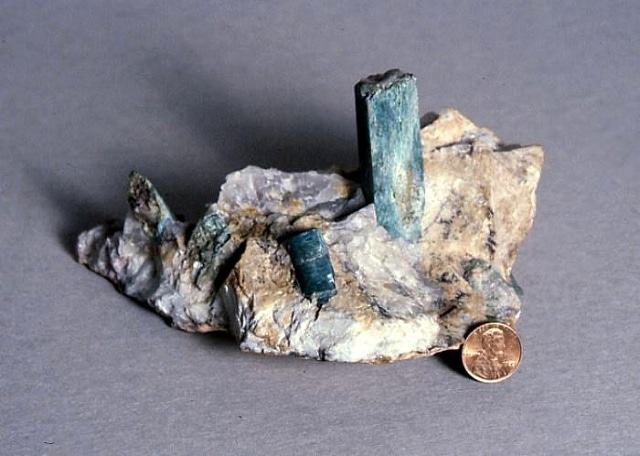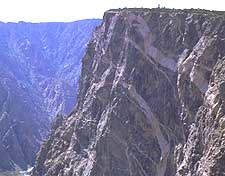‘Pegmatite’ is a general geological term for an igneous or metamorphic rock, with individual crystals of more than 3cm. Their coarse-grained texture characterizes them.
Compositionally, pegmatites often resemble granite in bulk chemistry, but they can also include significant amounts of Li2O, Rb2O, B2O3, F, and Cs2O. Pegmatites are found in many different geological settings; they are usually present in lenses or dikes, and the sizes can range from a few meters to many kilometers in width.
In 1979, Ginsburg et al. proposed a classification of pegmatitic rocks. The classification divides pegmatites into four major categories based on the depth of formation: shallow, intermediate, great depth, and maximal depth. Pegmatites are often used as sources of rare and precious metals and minerals.

A pegmatite rock from Mt. Apatite, from Maine State Museum. Image Credits: www.maine.gov
How are Pegmetitic Environments Formed?
The exact process of pegmatite formation, especially those of complex and zoned environments, is still an area of intense debate. Apart from this, the origin of pegmatites as metamorphic, igneous, or metasomatic is also the subject of many discussions.
The formation processes that lead to such large crystal sizes also appear complicated, but research would show that it is most likely a combination of low nucleation rates, high pressures, high diffusivity, continuous input of material into the system, and a consistently-reducing temperature.
In part, pegmatites do appear to be formed from the last batches of magma that crystallize in a granitic environment. This process enables pegmatites to have high water content, as well as other volatile and incompatible elements. This property is what makes pegmatitic environments important in the mining of exotic minerals.
Which Minerals Form in Pegmatitic Environments?
Pegmatites do not always contain minable amounts of minerals, but those which are formed in part through granitic intrusions often contain rare ‘lithophiles’ (elements that readily form silicates or oxides). These are the elements for which pegmatites are often mined. The major elements that are often present in extractable amounts include beryllium (Be), lithium (Li), tin (Sn), tungsten (W), rubidium (Rb), cesium (Cs) niobium (Nb), and tantalum (Ta).
Meanwhile, rare earth elements are elements that are thinly-dispersed in the earth’s crust, making them not economically-minable. Examples include cerium (Ce), yttrium (Y), and dysprosium (Dy). These rare earth elements are often present in pegmatites. Pegmatites that contain these minerals are called ‘rare element’ or ‘metal pegmatites’.
Pegmatites are also a good source of uranium, which is used extensively in the nuclear fuel industry. The origin of uranium in pegmatites may be due to further interaction with shales and pelites.

Pegmatite of Painted Wall. Image Credits: Lisa Lynch, www.nps.gov
Examples of Mining in Pegmatitic Environments
Lithium and Tantalum
Common lithium-bearing minerals in pegmatites include petalite, spodumene, and lepidolite. These materials are used extensively in the production of glass, ceramics, and fluxes, as well as in the production of lithium-compounds. Contemporary practices in lithium production saw a shift from the use of pegmatites to the use of brine; however, a large number of pegmatite reserves are still being exploited at present.
An example of this is the Greenbushes pegmatite in Western Australia, the largest lithium mineral resource on earth that provides 60 percent of the world’s lithium. The area is extremely high-grade, with the highest grade being 7.5 percent Li2O. Apart from this, the Greenbushes pegmatite is also the largest resource of hard-rock tantalum in the world, which is recovered via gravity separation.
The other two major producers of lithium minerals from pegmatites are Tanco in Canada and Bikita in Zimbabwe, with the former also producing large quantities of tantalum. Other minor producers of lithium include the Russian Federation, China, Argentina, and Brazil.
Some of the largest pegmatitic lithium reserves are found in the Democratic Republic of Congo, where two pegmatites—the Manono and Kittolo laccoliths—are spread at more than five kilometers. However, access to these sites is difficult, and as such, no economic significance is generated. The King’s Mountain pegmatites of North Carolina, meanwhile, are historically highly-productive with regards to hard-rock lithium, but they are now of less economic importance due to increased competition.
Beryllium
Only beryl, bertrandite, and phenakite are economically-viable to mine out of more than fifty types of beryllium. Traditionally, most beryllium was sourced from beryl which is commonly-found in pegmatitic environments. In recent years, the practice of beryl production through pegmatitic environments had considerably slowed-down, diminishing the economic capacity or impact of beryllium and pegmatites.
Uranium
Several pegmatitic regions have also been exploited for their uranium deposits. For instance, the Bancroft Field in Ontario is a major producer of uranium, with significant amounts of REE, Y, Ti, Ze, and Be minerals. The Rossing Deposit in Namibia is also a source of uranium; however, the quality is relatively lower-grade than other pegmatitic environments.
Surces and Further Reading
- Evans, A.M, Ore Geology and Industrial Minerals, An Introduction. 3rd ed. (Blackwell Science Ltd.,1993)
- Thomas, R and Webster, JD and Davidson, P (2006) Understanding Pegmatite Formation: The Melt And Fluid Inclusion Approach. In: Melt Inclusions in Plutonic Rocks. Short Course Series (36). Mineralogical Association of Canada, Montreal, Quebec, pp. 189-210.
- Quirke,T.T., Kremers, H.E. (1943) Pegmatite Crystallization, Mineralogical Society of America 28
- Jessica Elzea Kogel et al. (editors) Industrial Minerals & Rocks: Commodities, Markets, and Uses. 7th Ed. (SME, 2006)
- http://www.pegmatite.com/
- http://geology.about.com
This article was updated on 5th March, 2019.
Disclaimer: The views expressed here are those of the author expressed in their private capacity and do not necessarily represent the views of AZoM.com Limited T/A AZoNetwork the owner and operator of this website. This disclaimer forms part of the Terms and conditions of use of this website.